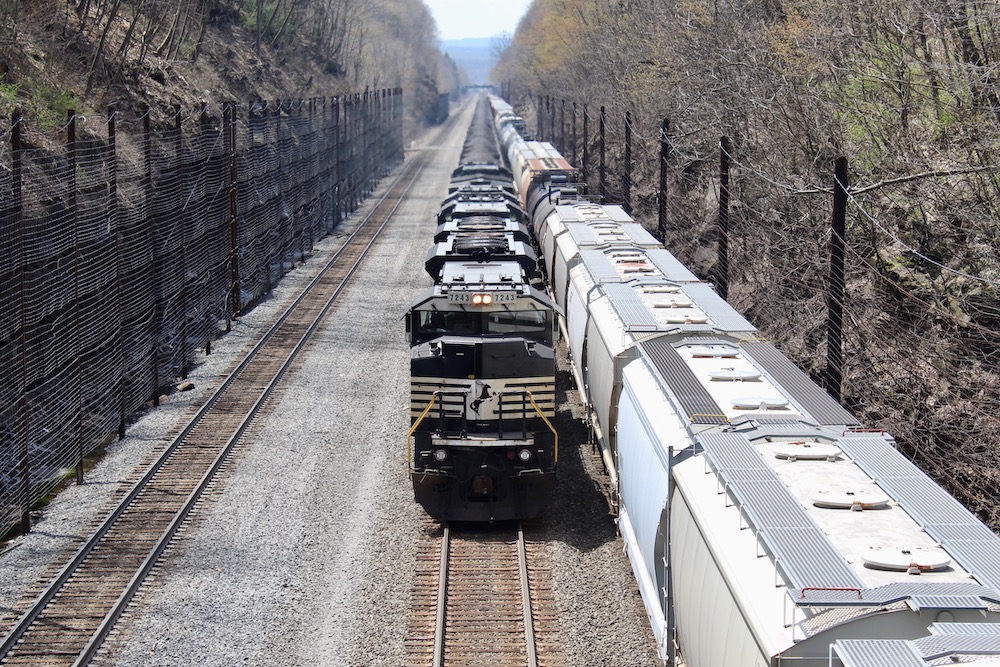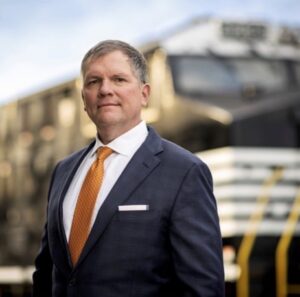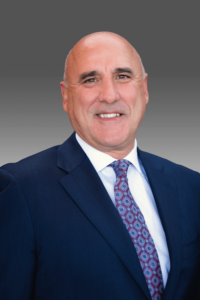
Trains sat down with Norfolk Southern CEO Alan Shaw and new Chief Operating Officer John Orr today to discuss the railroad’s strategy and response to activist investor Ancora Holdings. Ancora has launched a proxy battle to gain control of the Norfolk Southern board, and wants to appoint former UPS executive Jim Barber Jr. as CEO and former CSX operations boss Jamie Boychuk as chief operating officer. This Q&A was edited for brevity and clarity.
Q. Alan, when you outlined the better way forward strategy back in December 2022, the plan was to de-emphasize the operating ratio and not furlough train crews during downturns so you could capture volume during upswings and maintain service throughout the business cycle, which would allow customers to build more of their supply chains around the railroad. Now, in response to pressure from Ancora, the operating ratio is back as the largest component of the management incentive plan, and there’s a sub-60% operating ratio target. In addition, Norfolk Southern has cut 15% of its intermodal lanes. And you’ve hired an experienced Precision Scheduled Railroading executive, John Orr, as chief operating officer. What’s your strategy now?

Shaw: The strategy is the same. It’s this balanced approach between service, productivity, and growth with safety at its core. I’m committed to that. And the implementation of PSR as our operating plan is designed to execute that strategy. We changed our compensation structure, but O.R. was always in that because we had revenue and we had operating income. And you can figure out O.R. based on that. So we modified it based on some shareholder feedback. We still have revenue growth in there. We still have operating-income growth in there. Because that’s really important to our investors. We made a lot of improvements last year in safety and in service and we started growing our most service-sensitive franchise, but we didn’t deliver on productivity. I needed to accelerate our operational improvements, and so we hired John Orr.
Q. How do you reach a sub 60% operating ratio without cutting jobs?
Shaw: I don’t have to look too far. I can look in our boardroom and I can look at [former Canadian National CEO] Claude Mongeau. When he was at CN, he had an O.R. that was in the mid-50s and led the industry in growth. So look, these things are complimentary. Remember, revenue is one component of the operating ratio. Our cost structure is too high and we have identified about $550 million in productivity savings. That includes fuel, that’s purchased services and rents, that’s mechanical repairs, that’s recrews, and that’s overtime. There’s a number of ways in which we know that we can drive productivity, and that needs to be our focus.
Orr: The reason why I came here is I’m attracted to the business model. Alan’s vision is exactly where it needs to be. There’s nothing more important than re-establishing the reliability and competitiveness of rail. Having elasticity or resilience built into an operating plan is important for a number of reasons, because there are going to be emerging markets, there are going to be challenges that we’re faced with that we have to be able to respond to. And the Baltimore bridge collapse is a case in point where we’ve had to spin on a dime. I got together with [Chief Marketing Officer] Ed Elkins, the operating team, the marketing team, and we made a commercial deal with our coal providers to restructure where they went. They went from the mines down into Lambert’s Point, almost 800 more route-miles than Baltimore. We were able to move very quickly using the elasticity that we had built in. And so we get to a 60% O.R. by being able to respond to new opportunities, to be able to respond to challenges, and preserve our revenue because ultimately that’s one of the most important pieces of an O.R. The second piece, having the execution discipline to run the plan, is how we start to make savings. And you can see how the approach of having an optimization perspective on how terminals work relative to a network has proven to be very effective. We’ve reduced our locomotives by 75 just in three weeks, and we’re on a path to probably put down close to 300, maybe even more.
We’ve increased the velocity of the network by over 8%, taken down dwell by another 8%, and even the reduction of our bad-order counts by 41% in the two major terminals we’re looking at. So there’s a lot of work under the hood of those numbers that takes out costs, adds efficiencies. There are hundreds of examples of organic improvements that a mobilized, energized, and ignited workforce will bring us. And then there are big ticket items like fuel efficiencies, car discipline, lease returns, cutting up old cars that need to be scrapped and taking advantage of scrap prices, doing the things that make sense and add value to our customers.
Shaw: One of the things that John talks about is driving operational excellence by working in collaboration in conjunction with our customers, shortline partners, and other railroads, right? That preserves the opportunity for growth. And that’s exactly what you saw in our response to Baltimore, and that is exactly what our strategy is about: Working with our customers to develop logistics solutions for them in a dynamic global marketplace.
Q. One thing that Ancora said this morning is that the resilience model is incompatible with PSR. And CEO candidate Jim Barber said that when he was at UPS, he’d never keep a hundred thousand peak season hires on the job after peak season. How do you respond to that?
Shaw: One of the things that [Ancora Chief Operating Officer candidate] Jamie Boychuk said on that call today is that he would have to tear it down to the studs at Norfolk Southern. That’s incompatible with running a good franchise. PSR is not the strategy. Our strategy is that balance between service, productivity, and growth with safety at its core. PSR and the principles of PSR are the operating model. And what John is bringing to us is a different type of implementation, not tearing it down to the studs and trying to get to a sub-60% O.R. in one to two years. We’re doing it in a responsible and safe and measured way that preserves the opportunity for growth. We’re going to get to the same spot, but we’re going to do it in a way that protects our franchise, protects our shareholders for the long term, and protects our customers. I’m sure you saw that Stephens customer survey last week: 86% of the customers who responded to it said they’re aligned with our strategy. And 0% of the customers who responded said they’re aligned with Ancora’s. Eighty percent said they would pull business away from Norfolk Southern if we changed our strategy.

Orr: Let’s just call it like it is: When you have a railway CEO and an experienced seasoned architect for PSR, you take a different approach. Having the right amount of people giving you the right amount of value is important. This isn’t about sorting envelopes. These are heavy-haul solutions with some long lead time investments in people, in equipment, in infrastructure, in building bridges — not just renting an empty space in a commercial strip mall and putting Mother’s Day cards into packages.
Q. John, in a presentation last week, you mentioned current network improvement initiatives like identifying and eliminating bottlenecks and targeting large-volume yards for velocity and productivity improvements. Wasn’t Norfolk Southern already doing these things? What are you doing differently?
Orr: Well, I’m looking at it from a couple of points of view. First, I’m looking at a strategic point of view. How does the network move? How does a car get handled? So every time we find something that is a mismatch between cost and value, we’re able to eliminate it in the context of bringing it down to a terminal level. We have Conway Yard and Chattanooga Yard where we’ve got a task force optimizing and doing terminal clocks around the handling of a car. How does mechanical handle the car? If it can’t be moved because of a safety concern, how fast can it get fixed? And in Conway and in Chattanooga, we’ve reduced the handling time of that car to get repaired by almost 41%. So a lot of organic activity on finding solutions. And we’ve made a better connection standard. So we’ve taken the connection standard, the terminal dwell down by over 20%. Our target’s 30%, so we’re about two thirds of the way through. And our on-time performance in those two terminals has gone up from 30% to 90%. Not only are we running the terminals on time, we are running with the right amount of cars because we’re taking the anomalies out and making better connection standards. So you’re seeing the improvements across a number of fronts: car velocity, terminal dwell, network speed, and even productivity of our locomotives in our [gross ton-miles] for available horsepower. They’re all coming up.
Shaw: So what John’s explained is a high degree of compliance to the plan and what John brings to Norfolk Southern is this clarity of expectations and accountability and 40 years of direct hands-on experience doing this in three different countries. Driving operational excellence means safety and it means service and it means growth and it means productivity.
That’s what we’re looking for. That’s why we went out and got John because I wanted to accelerate our operational improvements.
Q. Ancora put out a more detailed plan today. It includes cost saving targets that add up to $800 million, which includes storing 450 locomotives, taking 35,000 cars out of service, and getting $200 million in fuel savings and $185 million from reduced switching. What do you make of these numbers?
Orr: You can say I’m going to take 200 cars out or 5,000 cars out or 100,000 cars out. But how does that affect the customer? How does it affect our ability to grow? How does that affect the cycle of shipments? I’ll tell you what was flawed in PSR 1.0. When you were in northern British Columbia and you were a lumber shipper and you were calling your commercial relationship and saying, where’s my cars? Well, they’re stuck. They’re behind a derailment or they’re in a snowstorm and they won’t be there for five days. Your plant shut down. Well, what am I looking at across the street? Well, those are your old cars that we’ve stored. They’re the center-beams that we can’t bring out. Well, can’t you just bring them over here? No, your cars are coming in five days. That is cutting cars and cutting costs to the detriment of the customer. Having a disciplined approach on how you serve those customers and how you rationalize assets is more important than the number. And I’ll give you a good example. Hunter [Harrison] tried to shut down CN’s Symington Yard in Winnipeg three times. And every time he had to put it back into play, he asked me to shut down Edmonton hump. It took me a few months to figure out how all of the terminals worked, how the traffic patterns worked, and I was able to shut the hump down by reallocating the work upstream, repurposing the yard in Edmonton, and making it work. So you can’t just irresponsibly say, I’m going to cut numbers without getting under the hood.
Shaw: John, you bring up a really good point. It’s easy to put out some kind of theoretical numbers when you haven’t set foot on the franchise and you’re not accountable for delivering those numbers. And if your statements are, ‘I’m going to take this thing down to studs,’ it’s pretty clear that’s that old short-term playbook in which shareholders lose. We’ve got a balanced approach that’s going to deliver long-term shareholder value with top-tier earnings growth at industry competitive margins. That’s where shareholders win.
Q. What does NS need to do to win the proxy contest? Why should investors support current management?
Shaw: They should support current management and the current board because we have an exceptional board that’s fit for purpose. We’ve got former CEOs, we have seven people on our board who’ve either been president or CEO of large-scale companies dealing with complex corporate issues. We’ve got a former four-star admiral and we have rail safety advocates on our board. If you just look at John and I, I’ve got 30 years experience in the rail industry with time and finance. I got a CFA, time and operations, and time and marketing, and you’ve got a 40-year veteran who’s delivered operational excellence and safety improvements wherever he’s gone. That’s a powerful combination. And we’ve got the right strategy for our franchise, which is that balance between service, productivity, and growth with safety at its core. And through John Orr we’ve got the ability to really execute that and accelerate our operational improvements. We’ve got a long-term strategy where shareholders are going to win. We don’t need to tear this thing down to the studs. We’re already making improvements. John’s been here three weeks. Within 48 hours, I was out in the field talking to one of his VPs in operations and the gentleman turned to me and said, you know what? We’re about to get a lot faster. A faster railroad is a less expensive railroad and a better service product. So we’re moving in the right direction. You see it in the metrics. The financial results will follow. And that’s why I’ve got a lot of confidence that we’re going to deliver that 400 to 500 basis point improvement in O.R. in the second half of this year and drive towards industry competitive margins and then leverage our unique franchise strengths and our unique strategy to deliver top-tier earnings growth.














These so called “activist” investors are nothing but – blowhard – know nothings -. They are single handedly destroying the Class I systems. They hold the short lines ransom. They ignore the shippers. They do not want single car loads. They have no interest in recapturing truck traffic. Why is it that they don’t use their hack and sack methods on the trucking industry anyway?
“We’re doing it in a responsible and safe and measured way that preserves the opportunity for growth.”: SAFE AND PRESERVES GROWTH! You store 450 locomotives that means you (in Ancora’s way of doing things) are getting rid of the crews to run them and running really long trains that cause all kinds of problems. We;;, what happens when you need some or all of 450 locomotives. You can’t use them because in your haste to get to a below 55% Operating Ratio you lost the trained crews that ran them. You chopped your nose off to spite your face. You will advertise for crew positions and will get untrained people who will take two years to filter in and maybe get trained, that is if your customers don’t mostly flee you for trucks because they can find trucks and drivers in half the time it takes to you to meet the federal regulations that locomotive engineers and conductors are required to meet before they can run one mile unsupervised. Yeah you cut it to the studs only to find out that the supply chain (getting replacements) is clogged or short materials and what you need has gone to work for the competition or for other available employment, Is it any wonder that CSX cut Boychuck loose before he could do REAL DAMAGE?
Ancora needs to understand the concept of YOU REAP WHAT YOU SOW. And any NS shareholder that votes with them ought find out whose hand it is they can feel in their pocket… BEFORE it is too late!
Bill, nice job (as always!) in bringing us this conversation. I, for one, stand with Shaw and Orr. If the Ancora crowd succeeds in the takeover, many will lose: employees, for sure but, most importantly, NS customers and short line connections. All will lose in the Ancora model.
Two flavors of PSR. Ultimately there is no substantive difference, only which bunch of executives become centimillionaires, at public expense of poor service. 15,000 foot, 250 trains going 40 mph max. EHH is the demon that keeps on giving from the grave.